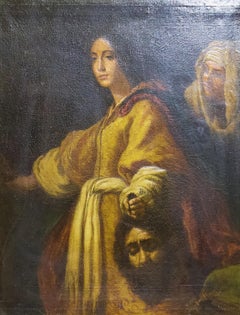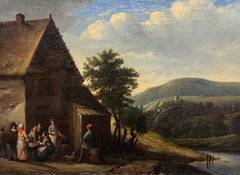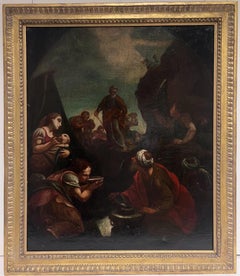Alessandro di Cristofano Allori Art
to
1
1
Overall Width
to
Overall Height
to
1
1
1
1
1
1
1
1
1
1
1
1
1
10,082
2,770
1,380
1,375
1
Artist: Alessandro di Cristofano Allori
Judith with the Head of Holofernes, Antique Oil Painting after Cristofano Allori
By Alessandro di Cristofano Allori
Located in Berlin, DE
Judith with the head of Holofernes, antique oil painting after Cristofano Allori.
Painting has been restored.
Dimensions without f...
Category
18th Century Old Masters Alessandro di Cristofano Allori Art
Materials
Canvas, Oil
Related Items
Figures Chatting outside Village Tavern in Mountain Landscape, Period Oil
By 19th century Dutch or Flemish school
Located in Cirencester, Gloucestershire
Dutch/ Flemish School, early 1800's
oil on canvas, framed
framed: 19 x 24 inches
canvas: 13.5 x 18.5 inches
provenance: private collection, France
condition: good and sound condition...
Category
Early 19th Century Old Masters Alessandro di Cristofano Allori Art
Materials
Oil, Canvas
17th Century Italian Old Master Oil Painting Moses Striking Water from the Rock
By Pier (Pietro) Dandini
Located in Cirencester, Gloucestershire
Moses Striking Water from the Rock;
Circle of Pietro Dandini, Italian 1646-1712
Italian School, late 17th century
oil on canvas, framed
framed: 3...
Category
Early 18th Century Old Masters Alessandro di Cristofano Allori Art
Materials
Canvas, Oil
$8,531
H 32 in W 28 in D 1 in
19th century English Portrait of a Young boy in a Cavalier costume
Located in Woodbury, CT
This elegant English 19th-century portrait of a young boy dressed in a Cavalier costume, painted circa 1860, is a striking example of Victorian portraiture that seamlessly combines h...
Category
1860s Old Masters Alessandro di Cristofano Allori Art
Materials
Canvas, Oil
Antique Roman painter - 18th century landscape painting - Wanderers - Italy
Located in Varmo, IT
Roman painter (18th century) - Landscape with Wayfarers.
43.5 x 34.5 cm unframed, 58.5 x 49.5 cm with frame.
Ancient oil painting on canvas, in a carved and gilded wooden frame (no...
Category
Early 18th Century Old Masters Alessandro di Cristofano Allori Art
Materials
Canvas, Oil
$1,194 Sale Price
44% Off
H 23.04 in W 19.49 in
Answer Within
Located in Ibadan, Oyo
Painting
Ships in a well-protected tube from Nigeria
This work is unique, this is not a print or other type of copy.
Accompanied by a Certificate of Authenticity (Issued by the Gallery)
Category
21st Century and Contemporary Old Masters Alessandro di Cristofano Allori Art
Materials
Canvas, Oil
A 17th c. Italian school, Capriccio with the Colosseum, circle of V. Codazzi
Located in PARIS, FR
A capriccio with the Colosseum in Roma
17th century Italian school
Circle of Viviano Codazzi (1604-1670)
Oil on canvas
Dimensions: h. 35.43 in, w. 51.18 in
Modern 17th century style ...
Category
17th Century Old Masters Alessandro di Cristofano Allori Art
Materials
Canvas, Oil
$13,016
H 40.94 in W 57.09 in
17th century follower of Rubens, two military men on horse back in a landscape
Located in Woodbury, CT
17th century English/Dutch School, from the Circle of Sir Peter Paul Rubens
A very interesting and well-painted 17th-century oil on canvas of two men seated on horseback in a landsc...
Category
1680s Old Masters Alessandro di Cristofano Allori Art
Materials
Canvas, Oil
$6,900 Sale Price
40% Off
H 16 in W 22 in
Fine 18th Century Italian Old Master Oil Painting Berghers with Animals Sunset
Located in Cirencester, Gloucestershire
The Close of Day
Italian School, early 18th century
oil on canvas, unframed
canvas: 17 x 22.5 inches
provenance: private collection, France
condition: very good and sound condition
Category
18th Century Old Masters Alessandro di Cristofano Allori Art
Materials
Oil, Canvas
19th Century English Antique, Two Country farmers drinking beer in a landscape
By George Morland
Located in Woodbury, CT
Attributed to George Morland.
19th Century English Antique, Two Country farmers drinking beer in a landscape.
Wonderful early 19th-century original oil on canvas.
A classic 'Morland' composition as the painter was a big fan of English Pub scenes...
Category
Early 1800s Old Masters Alessandro di Cristofano Allori Art
Materials
Canvas, Oil
$2,765 Sale Price
30% Off
H 20 in W 16 in
Antique Italian painter - 18th century figure painting
Located in Varmo, IT
Italian painter (18th century) - Chrono.
90.5 x 106 cm.
Antique oil painting on canvas, without frame (not signed).
Condition report: Lined canvas. Good state of conservation of t...
Category
Early 18th Century Old Masters Alessandro di Cristofano Allori Art
Materials
Canvas, Oil
$4,776 Sale Price
20% Off
H 35.63 in W 41.74 in
18th Century French Orientalist Portrait of Arab Man in Turban, oil painting
Located in Cirencester, Gloucestershire
Portrait of Arab Man in Turban
French artist, 18th century
oil on canvas, framed
Framed: 21 x 16.5 inches
Canvas : 18.5 x 14 inches
Provenance: private collection, France
Condition: ...
Category
18th Century Old Masters Alessandro di Cristofano Allori Art
Materials
Oil, Canvas
$2,525
H 21 in W 16.5 in
18th Century French Oil Painting Tavern Scene Interior Merry Making Figures
Located in Cirencester, Gloucestershire
Merry Makers in the Tavern
French School, 18th century
oil on canvas
canvas: 8 x 11 inches
provenance: private collection, France
condition: good and sound condition
Category
18th Century Old Masters Alessandro di Cristofano Allori Art
Materials
Oil, Canvas
Alessandro Di Cristofano Allori art for sale on 1stDibs.
Find a wide variety of authentic Alessandro di Cristofano Allori art available for sale on 1stDibs. You can also browse by medium to find art by Alessandro di Cristofano Allori in canvas, fabric, oil paint and more. Much of the original work by this artist or collective was created during the 18th century and is mostly associated with the Old Masters style. Not every interior allows for large Alessandro di Cristofano Allori art, so small editions measuring 28 inches across are available. Customers who are interested in this artist might also find the work of Giulio Di Sotto, George Morland, and Pietro Colonna. Alessandro di Cristofano Allori art prices can differ depending upon medium, time period and other attributes. On 1stDibs, the price for these items starts at $6,253 and tops out at $6,253, while the average work can sell for $6,253.


